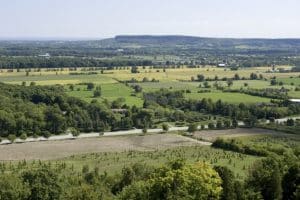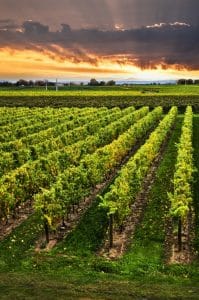 Less than five miles to the south of Lake Ontario and just above the Lake Iroquois Plain sits St. David’s Bench, a geographical formation carved out by glaciers when the Niagara Escarpment was formed. Marked by a steep ridge that gathers the cooling Lake Ontario breezes and circulates them back across the plains, the St. David’s Bench is one of the many sub-appellations unique to the Niagara Peninsula. Notable for its vastly varied topography, along with the fact that most of its slopes face north, the bench is just one more reason why Niagara wines bear such a wide variety of characteristics.
Less than five miles to the south of Lake Ontario and just above the Lake Iroquois Plain sits St. David’s Bench, a geographical formation carved out by glaciers when the Niagara Escarpment was formed. Marked by a steep ridge that gathers the cooling Lake Ontario breezes and circulates them back across the plains, the St. David’s Bench is one of the many sub-appellations unique to the Niagara Peninsula. Notable for its vastly varied topography, along with the fact that most of its slopes face north, the bench is just one more reason why Niagara wines bear such a wide variety of characteristics.
For any lover of fine wines — especially one planning to visit Niagara — the question of what makes a particular region’s wine stand out from another’s is a topic of never-ending discussion. Here is a brief foray into that conversation, with a spotlight trained on the St. David’s Bench wines.
Terroir
As with every Niagara Peninsula wine, the terroir of St. David’s Bench is quite unique. The elevation of the bench ranges from 350 to 500 feet above sea level, which makes it one of the higher elevation sub-appellations in Niagara. While that higher elevation could make for a harsher climate, the bluffs there, combined with the planting of most vineyards on north-facing slopes, provide plenty of shelter.
The area is crossed by numerous shallow streams, and spring sees plenty of flooding. The soil is spread across a bedrock of sandstone, and while it’s mostly clay, and, therefore, holds in plenty of moisture, it drains well enough so that the vines have an easy time of growing throughout the warmer months. Still, the vineyards of St. David’s Bench do enjoy cooler temperatures than most other appellations — especially late in the growing season when the grapes are ripening. A warmer and earlier spring is met eventually with the cooler ripening. It makes for grapes capable of producing more mature, round, and sophisticated wines.
The Wineries
 Of course, all the specifics of a region’s terroir matter little if there aren’t winemakers and growers to work their magic in the midst of it. St. David’s Bench is such a small appellation that it has just a handful of wineries. Here is a brief look at a few of them:
Of course, all the specifics of a region’s terroir matter little if there aren’t winemakers and growers to work their magic in the midst of it. St. David’s Bench is such a small appellation that it has just a handful of wineries. Here is a brief look at a few of them:
- Chateau des Charmes. This excellent winery was among the first in the entire region to plant its vineyards in vinifera grapes — just one of the reasons it is often credited with being part of what helped transform Niagara’s wine reputation around the world.
- Niagara College Teaching Winery. More than just the area’s premier wine teaching school, the Niagara College Teaching Winery also produces some of the area’s finest wines.
- Colaneri Estate Winery. A beautiful winery, their tasting room is situated so visitors can look into the heart of their winemaking production while the work is underway.
- Ravine Vineyard Estate Winery. If you like your world-class wine served up with a side of world-class architecture, a visit to Ravine is in order. Their wine-tasting center sits in the Georgian Woodruff House, a 200-year-old home that is one of Canada’s most prized and architecturally significant buildings.
Dive into Niagara wine, one sub-appellation at a time. As this closer look at St. David’s Bench shows, even the smallest spots are capable of noteworthy things.
